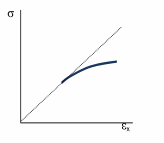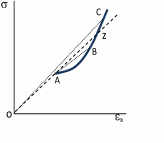The Explicit Dynamics systems are particularly well suited to capturing various types of wave propagation phenomena in solid and liquid materials.
Different types of elastic waves can propagate in solids depending on how the motion of points in the solid material is related to the direction of propagation of the waves (Meyers [2]). The primary elastic wave is usually referred to as the longitudinal wave. Under uniaxial stress conditions (i.e. an elastic wave traveling down a long slender rod), the wave propagation speed is given by
(10–10) |
For the more general three-dimensional case, the additional components of stress lead to the more general expression for the primary longitudinal elastic wave speed
(10–11) |
The secondary elastic wave is usually referred to as the distortional/shear wave and it’s propagation speed can be calculated as
(10–12) |
Other forms of elastic waves include surface (Rayleigh) waves, Interfacial waves and bending (or flexural) waves in bars/plates. Further details are provided by Meyers [2].
Plastic (inelastic) deformation takes place in a ductile metal when the stress in the material exceeds the elastic limit. Under dynamic loading conditions the resulting wave propagation can be decomposed into elastic and plastic regions (Meyers [2]). Under uniaxial strain conditions, the elastic portion of the wave travels at the primary longitudinal wave speed whilst the plastic wave front travels at a local velocity
(10–13) |
For an elastic perfectly plastic material, it can be shown [3] that the plastic wave travels at a slower velocity than the primary elastic wave
(10–14) |
Typical stress strain curves for a ductile metal under uniaxial stress and uniaxial strain conditions are given below.
Under uniaxial stress conditions, the tangent modulus of the stress strain curve decreases with strain. The plastic wave speed therefore decreases as the applied jump in stress associated with the stress wave increases – shock waves are unlikely to form under these conditions.
Under uniaxial strain conditions the plastic modulus (AB) increases with the magnitude of the applied jump in stress. If the stress jump associated with the wave is greater than the gradient (OZ), the plastic wave will travel at a higher speed than the elastic wave. Since the plastic deformation must be preceded by the elastic deformation, the elastic and plastic waves coalesce and propagate as a single plastic shock wave.
A shock wave can be considered to be a discontinuity in material state (density(ρ), energy(e), stress(σ), particle velocity(u)) which propagates through a medium at a velocity equal to the shock velocity (Us ).
Relationships between the material state across a shock discontinuity can be derived using the principals of conservation of mass, momentum and energy. The resulting Hugoniot equations are given by
(10–15) |
(10–16) |
(10–17) |





